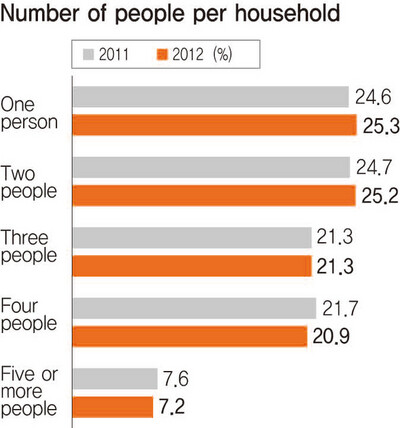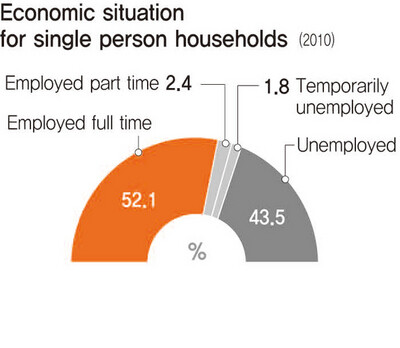hankyoreh
Links to other country sites 다른 나라 사이트 링크
Single-person households growing, but left out in the cold

By Choi Hyun-june, staff reporter
Ten years after moving to Seoul from Busan, Song could finally afford a lease on her house. At first she applied for a government mortgage, which is provided at an interest rate of 2 or 3%. But Song, 29, didn’t qualify because she lives alone. Instead, she borrowed 33 million won (US$30,000) from the bank at an interest rate of more than 5%.
“Since the bank’s high interest rate came to me as a burden, I had to find a semi-basement room,” Song said. “I haven’t gotten any government benefits: no tax breaks, no low-interest mortgage. I have to live in an area where I don’t feel safe and I feel like I’m being ignored by the country I was born in.”
One in four households in Korea is now occupied by just one person, the largest portion ever recorded since statistics started being collected. According to Statistics Korea’s Population Projections by Provinces report, in 2011 there were 4.53 single person households in the country, 25.3% of the total. There were 4.52 million two-person households. The social welfare system has yet to acknowledge this demographic trend and still prioritizes multi-person households when allocating resources.

In 1980, only 4.8% of households were single-person. That number is expected to rise to 34.3% by 2035. By that year, it is estimated that South Jeolla province (42.3%), North Gyeongsang province, and Gangwon province (both 40.9%) will have high rates of single-person households, while Ulsan (28.4%), Gyeonggi province (30.1%), and Seoul (30.8%) will have lower rates.
It is tough to live alone. According to the Korea Labor Institute’s analysis of Family Trend Research conducted by Statistics Korea, the average age of people who live alone is 57.9 years old. 26% of people living alone are over 65 years old and 54% are women.
Those who live alone tend to spend more than 80% of their income, which is higher than multi-person households, which spend 79.2%. The rate of monthly rent housing is 26.7%, more than twice of multi-households at 10.3%.
The ratio of low-income class is higher in single-person households, too. According to the investigation of real state of poverty by the Ministry of Health and Welfare, 60% of the households receiving Basic Livelihood Allowance were single-person households.
Byeon Mi-ri, a researcher from the Seoul Institute, said, “There is this idea of the ‘fancy single life’, but the reality faced by people who live alone is a lot different from that.”
They are the first ones to be excluded from tax deductions. Basic Deduction, or deduction of income, depends on the number of dependents. Both Deduction for Women and Personal Exemption per Month are only available when one has a spouse or dependents.
“I regret not getting married when year-end tax adjustment is done. I don’t get any benefits like my married colleagues do,” said Lee Sang-joon, 36.
For single-person households, just finding housing is a problem in itself. While the number of single-person households is increasing, the number of small homes is decreasing. In 1995, 40m2 houses were 11.2%, but in 2010 those decreased to 9.2%. But the rate of single-person household doubled from 12.7% in 1995 to 23.9% in 2010. The city of Seoul only provided 75 of small-sized housing last year.
Ban Jeong-ho a researcher for the Korea Labor Institute said, “Houses are commonly thought of as a good investment, and they got bigger. The number of rental houses provided by the government is decreasing and causing problems for single people who are looking for housing.”
The same situation is repeated in the social welfare system. The Earned Income Tax Credit (EITC), which gives additional support to low-income families, only applies to people who have spouses or dependents. The government decided to expand the benefits to low-income people who are over 65 years old, as accepting the request of criticism that the policy excluded single-person households.
A source from the Ministry of Strategy and Finance said, “The system was originally designed for multi-households. But we will gradually broaden the range.”

Other than that, single-person household also cannot apply for long-term public rental housing, called SHIFT, offered by SH corporation. Households with more than three people have priority to get those public rental housings. While nowadays many politicians are competing to devise new welfare measures, no policy has been put forth for single person households.
While the government sits idle, some corporations are responding to this trend. They have recognized the growing number of single-person households and are coming up with products geared particularly to them.
But there is still tacit discrimination of single families. Park, 34, said, “I just hope I can finish my meal in the restaurant without any discriminative looks.”
Translated by Kim Ji-seung, Hankyoreh English intern
Please direct questions or comments to [english@hani.co.kr]

Editorial・opinion
![[Editorial] Does Yoon think the Korean public is wrong? [Editorial] Does Yoon think the Korean public is wrong?](https://flexible.img.hani.co.kr/flexible/normal/500/300/imgdb/original/2024/0417/8517133419684774.jpg) [Editorial] Does Yoon think the Korean public is wrong?
[Editorial] Does Yoon think the Korean public is wrong?![[Editorial] As it bolsters its alliance with US, Japan must be accountable for past [Editorial] As it bolsters its alliance with US, Japan must be accountable for past](https://flexible.img.hani.co.kr/flexible/normal/500/300/imgdb/original/2024/0417/6817133413968321.jpg) [Editorial] As it bolsters its alliance with US, Japan must be accountable for past
[Editorial] As it bolsters its alliance with US, Japan must be accountable for past- [Guest essay] Amending the Constitution is Yoon’s key to leaving office in public’s good graces
- [Editorial] 10 years on, lessons of Sewol tragedy must never be forgotten
- [Column] A death blow to Korea’s prosecutor politics
- [Correspondent’s column] The US and the end of Japanese pacifism
- [Guest essay] How Korea turned its trainee doctors into monsters
- [Guest essay] As someone who helped forge Seoul-Moscow ties, their status today troubles me
- [Editorial] Koreans sent a loud and clear message to Yoon
- [Column] In Korea’s midterm elections, it’s time for accountability
Most viewed articles
- 1[Column] The clock is ticking for Korea’s first lady
- 2[Guest essay] How Korea turned its trainee doctors into monsters
- 3Samsung barricades office as unionized workers strike for better conditions
- 4S. Korea, Japan reaffirm commitment to strengthening trilateral ties with US
- 5[Editorial] When the choice is kids or career, Korea will never overcome birth rate woes
- 6Gangnam murderer says he killed “because women have always ignored me”
- 7[Editorial] As it bolsters its alliance with US, Japan must be accountable for past
- 8[News analysis] After elections, prosecutorial reform will likely make legislative agenda
- 9Korea, Japan jointly vow response to FX volatility as currencies tumble
- 10US exploring options for monitoring N. Korean sanctions beyond UN, says envoy